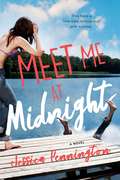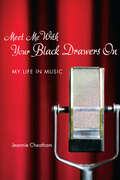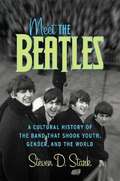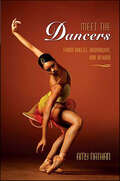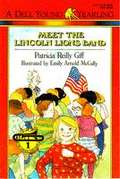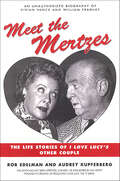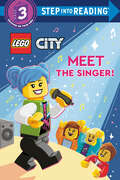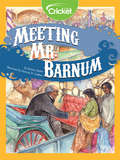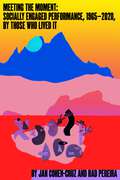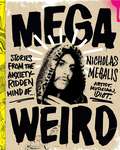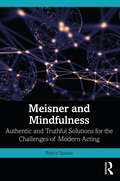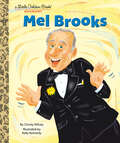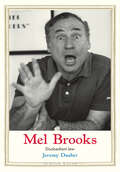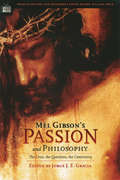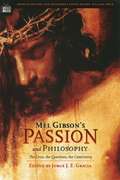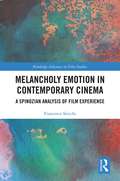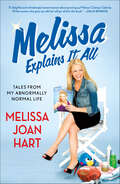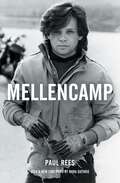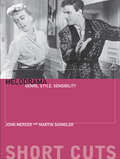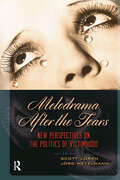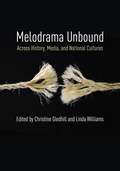- Table View
- List View
Meet David Sedaris: Series Two (Radio 4 series)
by David SedarisDavid Sedaris's remarkable ability to uncover the hilarious absurdity teeming just below the surface of everyday life is surpassed only by his ability to make his stories even more hilarious when he reads them aloud. This is his second series for Radio 4, and he reads diary entries and essays from his books.Episode 1The Incomplete QuadThe Squirrel and the ChipmunkEpisode 2Me Talk Pretty One DayIt's CatchingEpisode 3Nuit of the Living DeadThe End of the AffairEpisode 4Us and ThemDiary extractsEpisode 5Memento MoriThe Motherless BearEpisode 6The Ship ShapeMake That a Double
Meet Me at Midnight
by Jessica PenningtonTeens waging a war of practical jokes declare peace when they fall for one another in this charming YA romantic comedy from Jessica Pennington.They have a love-hate relationship with summer.Sidney and Asher should have clicked. Two star swimmers forced to spend their summers on a lake together sounds like the perfect match. But it’s the same every year—in between cookouts and boat rides and family-imposed bonfires, Sidney and Asher spend the dog days of summer finding the ultimate ways to prank each other. And now, after their senior year, they’re determined to make it the most epic yet. But their plans are thrown in sudden jeopardy when their feud causes their families to be kicked out of their beloved lake houses. Once in their new accommodations, Sidney expects the prank war to continue as usual. But then she gets a note—Meet me at midnight. And Asher has a proposition for her: join forces for one last summer of epic pranks, against a shared enemy—the woman who kicked them out. Their truce should make things simpler, but six years of tormenting one another isn’t so easy to ignore. Kind of like the undeniable attraction growing between them.At the Publisher's request, this title is being sold without Digital Rights Management Software (DRM) applied.
Meet Me with Your Black Drawers On: My Life in Music
by Jeannie CheathamJeannie Cheatham is a living legend in jazz and blues. A pianist, singer, songwriter, and co-leader of the Sweet Baby Blues Band, she has played and sung with many of the greats in blues and jazz - T-Bone Walker, Dinah Washington, Cab Callaway, Joe Williams, Al Hibbler, Odetta, and Jimmy Witherspoon. Cheatham toured with Big Mama Thornton off and on for ten years and was featured with Thornton and Sippie Wallace in the award-winning PBS documentary Three Generations of the Blues. Her music, which has garnered national and international acclaim, has been described as unrestrained, exuberant, soulful, rollicking, wicked, virtuous, wild, and truthful. Cheatham's signature song, "Meet Me with Your Black Drawers On" is a staple in jazz and blues clubs across America and in Europe, Africa, and Japan. In this delightfully frank autobiography, Jeannie Cheatham recalls a life that has been as exuberant, virtuous, wild, and truthful as her music. She begins in Akron, Ohio, where she grew up in a vibrant multiethnic neighbourhood surrounded by a family of strong women. From those roots, she launched a musical career that took her from the Midwest to California, doing time along the way everywhere from a jail cell in Dayton, Ohio, where she was innocently caught in a police raid, to the University of Wisconsin-Madison - where she and Jimmy Cheatham taught music. Cheatham writes of a life spent fighting racism and sexism, of rage and resolve, misery and miracles, betrayals and triumphs, of faith almost lost in dark places, but mysteriously regained in a flash of light. Cheatham's autobiography is also the story of her fifty-years-and-counting love affair and musical collaboration with her husband and band partner, Jimmy Cheatham.
Meet the Beatles: A Cultural History of the Band That Shook Youth, Gender, and the World
by Steven D. StarkA discussion of the trends that created and followed the Beatles, tales of each members childhood,how their style represents mild gender bending, and attempts to describe their many long term impacts.
Meet the Dancers: From Ballet, Broadway, and Beyond
by Amy NathanLots of kids enjoy dancing, but what motivates them to push past the sore muscles, early-morning technique classes, and crazy schedule required to become a professional dancer? In this book, dancers from many backgrounds talk about their different paths to success in ballet, modern, jazz, Broadway, and hiphop. They also share advice and helpful tips, such as: • practice interpreting the music and the mood of a movement, even when you're doing a standard warm-up exercise • try to be in the front row at auditions so you can see what's going on and so the judges know you're eager to be seen
Meet the Lincoln Lions Band
by Patricia Reilly GiffPa-dum. Pa-dum. Pa-dum. There's going to be a marching band at the Lincoln School! Drums...fifes...new uniforms...parades! Chrissie Tripp is going to sign right up. She just knows she'll make a great band kid. She's so sure, she tells her new friend, Michelle, she's already in the band. But then, gonzo! The president of the school, who just happens to be Chrissie's big-mouth sister, Theresa, makes a horrible announcement about the Lincoln Lions Band. If Chrissie doesn't do something fast, she's going to look like a liar--a big liar. Chrissie's new school year is off to a bad start. She cuts through the neighbor's yard, she sneaks in to school when she's not allowed, the teacher makes her sit in the trouble-maker's seat, she draws an ugly picture of her teacher, makes up nasty names for the new kids, lies about being in the band, breaks her sister's birthday present, gets in a big fight, and does more things she shouldn't. What she really wants is to be in the band, to do something important and to make friends and be happy in school. You'll love reading about this girl who is like lots of kids you know.
Meet the Mertzes: The Life Stories of I Love Lucy's Other Couple
by Rob Edelman Audrey KupferbergMeet the Mertzes is an expansive dual biography chronicling the lives of two of America's most popular situation-comedy actors, William Frawley and Vivian Vance, who portrayed Fred and Ethel Mertz on I Love Lucy. This meticulously researched book contains interviews with Frawley's and Vance's colleagues, friends, and relatives, and explores their personal and professional lives before, during, and after I Love Lucy. With a complete filmography and videography of each, Meet the Mertzes finally sets the record straight on the lives and legacies of these compelling stars who detested one another.You'll learn about:-Vance's successful Broadway career prior to I Love Lucy-Frawley's vaudevillian roots and his passion for baseball-Vance's nervous breakdown after the collapse of her first marriage-Frawley's drinking and carousing-Lucille Ball's caustic relationship with both of her costars-Vance's hatred of being known to the world as Ethel Mertz
Meet the Moviemakers (Fountas & Pinnell Classroom, Guided Reading Grade 4)
by Laura DowerNIMAC-sourced textbook
Meet the Singer! (Step into Reading)
by Steve FoxeLEGO© City fans will love this new MEET THE…LEGO City Step into Reading leveled reader series, featuring exciting careers including an astronaut, a singer, a firefighter, and more!Children ages 4 to 8, will love reading about Madison and Billy as they interview singing sensation Poppy Starr in this Step 3 Step into Reading leveled reader!Step 3 readers feature engaging characters in easy-to-follow plots about popular topics. For children who are ready to read on their own.LEGO, the LEGO logo, the Brick and Knob configurations and the Minifigure are trademarks of the LEGO Group.
Meeting Mr. Barnum
by Patricia BaehrDespite a horrible snowstorm, Josephine—a young immigrant girl from Italy—is determined to meet the famous circus showman, P.T. Barnum ,and ask him how he made his fortune. When her determination turns into pure stubbornness and gets her into a bind, how will she achieve her goal?
Meeting the Moment: Socially Engaged Performance, 1965–2020, by Those Who Lived It
by Jan Cohen-Cruz Rad PereiraThe experiences of a diverse range of progressive theater and performance makers in their own words.Curated stories from over 75 interviews and informal exchanges offer insight into the field and point out limitations due to discrimination and unequal opportunity for performance artists in the United States over the past 55 years. In this work, performers, often unknown beyond their immediate audience, articulate diverse influences. They also reflect on how artists are educated and supported, what content is deemed valuable and how it is brought to bear, as well as which audiences are welcome and whether cross-community exchange is encouraged. The book’s voices bring the reader from 1965 through the first wave of the covid-19 pandemic in 2020. They point to more diverse and inclusive practices and give hope for the future of the art.
Mega Weird
by Nicholas Megalis Tom MegalisA collection of hilarious short stories from twenty-five year old Internet sensation Nicholas Megalis on his distinctively weird life and childhood, fully illustrated by Tom Megalis, his celebrated artist and animator dad.From Internet sensation Nicholas Megalis, comes Mega Weird, a collection of hilarious short stories on life as an anxiety-fueled artist, musician, and proudly weird dude.Raised in a ridiculous family of artists, Greek immigrants, and all-around weirdos, Megalis has had a strange and beautiful ride (and has consumed an ungodly amount of spanakopita). Mega Weird is an illustrated journal of Megalis's twenty-five years on this planet--borderline fireworks pyromania, chain-smoking at age seven, psychotic magic trick obsessions, the perils of being a thirteen-year-old boy, a month-long band tour fueled by Taco Bell, caffeine, and guitars--each story accompanied by original art from his celebrated artist and animator dad, Tom Megalis.Mega Weird is an assurance that it's okay to be different. In fact, it's essential. Megalis wasn't good at sports and could barely tie his shoes until he was twenty, but that's fine. Who cares? He's proud to be weird. And you should be too. Life is insane, life is great. Thank God for rock and roll.
Megan Owlet
by Beth Anne MarescaMegan Owlet doesn’t want to play basketball, learn karate, or practice the violin. Every day she goes and cheers her brothers on as they participate in their own activities, but one morning she wakes up and realizes she’s bored! It’s time for Megan to find something of her own to do. After an unsuccessful brainstorming session with her animal friends, Megan stumbles upon a dance studio, and with an excited screech she begins to dream big dreams of whirls and twirls. Dancing is trickier than Megan expected, but with a little help from her brothers, Megan can do anything! From debut author and illustrator Beth Anne Maresca, Megan Owlet teaches children to pursue their own dreams and to be brave in making them happen. This is a story about love, support, and family, and parents and children alike will be enchanted by its heartwarming ending and beautiful watercolor illustrations.
Meisner and Mindfulness: Authentic and Truthful Solutions for the Challenges of Modern Acting
by Royce SparksMeisner and Mindfulness: Authentic and Truthful Solutions for the Challenges of Modern Acting is the first book that reveals how Meisner and mindfulness can be united to create strong results for actors and help them navigate the challenges of the digital age. The twenty-first century has created an entirely new set of demands and pressures on the working actor, including an acceleration of the digital age and the complications of COVID-19, which have led to auditions, rehearsals, and even whole performances happening entirely in isolation. This book combines a modern rethinking of the Meisner technique with a complementary set of tools from mindfulness meditation to offer profound solutions to these growing challenges, addressing the demands of a post-coronavirus industry as well as the pressures of acting in the digital era. In this ground-breaking expansion of the technique, readers will discover how it is possible to train some of the deepest values of living truthfully under a given set of circumstances, both with other actors and whilst alone. Since the 1950s the Meisner technique has aided the actor in navigating the demands unique to their time. This book is a powerful reminder that, even in the midst of so many changes and challenges, the truthfulness that has defined outstanding performances across generations is still within reach. Full of easily accessible mindfulness and Meisner exercises and principles for practice-based support, Meisner and Mindfulness will be illuminating to working actors, directors, students and instructors of acting, and practitioners of the Meisner technique looking to develop the authenticity, immediateness, and closeness essential to great acting. The book also includes access to an online supplement featuring additional exercises and concepts, including new ways to incorporate Meisner exercises into training sessions, suggestions for how Meisner-oriented companies can use exercises such as repetition in rehearsals, and discussions for how to set up a facilitated Meisner group.
Mel Brooks: A Little Golden Book Biography (Little Golden Book)
by Christy MihalyHelp your little one dream big with a Little Golden Book biography about comedian, actor, and filmmaker Mel Brooks. Little Golden Book biographies are the perfect introduction to nonfiction for young readers—as well as fans of all ages!This Little Golden Book about Mel Brooks--legendary EGOT funnyman and director of classics such as Young Frankenstein and The Producers--is an inspiring read-aloud for young children and their parents and grandparents who are fans.Look for more Little Golden Book biographies: • Betty White • Carol Burnett • Lucille Ball • Harry Belafonte • Julie Andrews • Dwayne Johnson
Mel Brooks: Disobedient Jew (Jewish Lives)
by Jeremy DauberA spirited dive into the life and career of a performer, writer, and director who dominated twentieth-century American comedy Mel Brooks, born Melvin Kaminsky in Brooklyn in 1926, is one of the great comic voices of the twentieth century. Having won almost every entertainment award there is, Brooks has straddled the line between outsider and insider, obedient and rebellious, throughout his career, making out-of-bounds comedy the American mainstream. Jeremy Dauber argues that throughout Brooks&’s extensive body of work—from Your Show of Shows to Blazing Saddles to Young Frankenstein to Spaceballs—the comedian has seen the most success when he found a balance between his unflagging, subversive, manic energy and the constraints imposed by comedic partners, the Hollywood system, and American cultural mores. Dauber also explores how Brooks&’s American Jewish humor went from being solely for niche audiences to an essential part of the American mainstream, paving the way for generations of Jewish (and other) comedians to come.
Mel Gibson's Passion and Philosophy
by William Irwin Jorge J. GraciaMel Gibson's The Passion of the Christ has become one of the most controversial films ever made, and it is already a blockbuster of cinematography. Its defenders passionately regard it as one of the most moving and influential pieces of religious art ever created. But its detractors argue with comparable vehemence that the violence and gore it contains, its alleged anti-Semitism, a particular take on the Christian message, and the lack of historical and Biblical accuracy, make it nothing more than a kind of political propaganda. Father Thomas Rosica hailed as one of the great masterpieces of religious art, but the secular humanist Paul Kurtz thinks of it as a political weapon in the hands of the religious right. Film critics are divided in their judgment, giving the film anywhere from no stars to five stars. Regardless of what one thinks of the film, however, its impact both personal and social is beyond question.
Mel Gibson's Passion and Philosophy: The Cross, the Questions, the Controversy
by Jorge J. E. GraciaIn Mel Gibson's Passion and Philosophy (Volume 10 in the series, Popular Culture and Philosophy), twenty philosophers with widely varying religious and philosophical backgrounds examine all the most important issues raised by the movie (The Passion of the Christ, Mel Gibson's spectacular film about the death of Jesus), without ridicule or rancor.
Melancholy Emotion in Contemporary Cinema: A Spinozian Analysis of Film Experience (Routledge Advances in Film Studies)
by Francesco SticchiThis work outlines a new methodology for film analysis based on the radical materialist thought of Baruch Spinoza, re-evaluating contemporary cognitive media theory and philosophical theories on the emotional and intellectual aspects of film experience. Sticchi’s exploration of Spinozian philosophy creates an experiential constructive model to blend the affective and intellectual aspects of cognition, and to combine it with different philosophical interpretations of film theory. Spinoza’s embodied philosophy rejected logical and ethical dualisms, and established a perfect parallelism between sensation and reason and provides the opportunity to address negative emotions and sad passions without referring exclusively to traditional notions such as catharsis or sublimation, and to put forth a practical/embodied notion of Film-Philosophy. This new analytical approach is tested on four case studies, films that challenge the viewer’s emotional engagement since they display situations of cosmic failure and depict controversial and damaged characters: A Serious Man (2009); Melancholia (2011); The Act of Killing (2012) and Only Lovers Left Alive (2013). This book is an important addition to the literature in Film Studies, particularly in Cognitive Film Theory and Philosophy of Film. Its affective and semantic analyses of film experience (studies of embodied conceptualisation), connecting Spinoza’s thought to the analysis of audiovisual media, will also be of interest to Philosophy scholars and in academic courses of film theory, film-philosophy and cognitive film studies.
Melissa Etheridge
by Chris NicksonChris Nickson's biography of Melissa Etheridge explores the pop star's life and music. Born in Leavenworth, Kansas, Melissa Etheridge faced years of struggle and hard work to make it in the music business. But through it all, she's remained determined, and now has multiple platinum records and Grammys to her name and an original sound that's all her own. Nickson tells the whole story in this biography fans are sure to enjoy.
Melissa Explains It All: Tales from My Abnormally Normal Life
by Melissa Joan HartMelissa Joan Hart explained it all-from dating to bullies-in her groundbreaking role as Clarissa Darling on Clarissa Explains It All. She cast a spell on millions more viewers as Sabrina, the Teenage Witch. Now, in Melissa Explains It All, Melissa tells the frank and funny behind-the-scenes stories from her extraordinary past and her refreshingly normal present.Melissa has been entertaining audiences most of her life; when there were no girls named Melissa on her favorite show, the forceful four year old decided she'd get on television her way. From that moment on, Melissa has shown a singular determination and focus-whether it's for booking three national commercials so her dad would build her a tree house or for nailing the audition for Clarissa. From her first commercial to her current starring role in ABC Family's hit Melissa andJoey, Hart never let fame go to her head. She always had one foot in Hollywood and one foot in reality-and still does. Melissa makes us laugh along with her as she talks about:--guest appearances in shows like Saturday Night Live and The Equalizer--auditioning for Punky Brewster and Clarissa--her early Broadway days--wacky parties she's thrown and attended-- the actors who influenced her and whom she befriended, worked with and competed against --her experiences both on and off-set-with Sabrina's Salem the Cat and Elvis the Alligator on Clarissa--how she met the love of her life at the Kentucky Derby Melissa Joan Hart explains all that she's learned along the way-what's kept her grounded, normal and working when others have not been so fortunate-and that she's the approachable, hilarious girl-next-door her fans have always thought she'd be.
Mellencamp
by Paul ReesThe definitive biography of John Mellencamp, the iconic American rock and roll original, featuring exclusive in-depth interviews and never-before-told details. Perfect for fans of Janis and Born to Run.John Mellencamp is not your typical rock star. With music inspired by the work of William Faulkner, John Steinbeck, and other giants of American literature, he has experienced a colorful career unlike any other. Now, this fascinating biography fully charts the life of one of this country&’s most important voices in American music. Mellencamp&’s story is also the story of the American heartland. His coming of age as an artist and evolution into legendary status directly reflected the major changes of the last fifty years. From the Summer of Love to the growing divisiveness of American politics and beyond, his music has served as the backdrop to this evolving country for millions of fans. Featuring exclusive interviews with friends, family, and colleagues, and exploring everything from the founding of Farm Aid to his induction into the Rock and Roll Hall of Fame, this is a fresh and expansive look at a true original.
Melodrama
by Martin Shingler John MercerMelodrama: Genre, Style and Sensibility is designed as an accessible overview of one of the most popular genres at undergraduate Film Studies. The book identifies three distinct but connected concepts through which it is possible to make sense of melodrama; either as a genre, originating in European theatre of the 18th and 19th century, as a specific cinematic style, epitomised by the work of Douglas Sirk or as a sensibility that emerges in the context of specific texts, speaking to and reflecting the desires, concerns and anxieties of audiences. Films discussed include All That Heaven Allows, Safe, Fear Eats the Soul, Black Narcissus, Suddenly Last Summer and Rebel Without a Cause. Each chapter includes overviews of key essays, analyses of significant and widely studied films and includes an annotated reading list.
Melodrama After the Tears: New Perspectives on the Politics of Victimhood (Film Culture in Transition)
by Jörg Metelmann Scott LorenMelodrama, it is said, has expanded beyond the borders of genre and fiction to become a pervasive cultural mode. It encompasses distinct signifying practices and interpretive codes for meaning-making that help determine the parameters of identification and subject formation. From the public staging of personal suffering or the psychologization of the self in relation to consumer capitalism, to the emotionalization and sentimentalization of national politics, contributions to this volume address the following question: If melodramatic models of sense-making have become so culturally pervasive and emotionally persuasive, what is the political potential of melodramatic victimhood and where are its political limitations? This volume represents both a condensation and an expansion in the growing field of melodrama studies. It condenses elements of theory on melodrama by bringing into focus what it recognizes to be the locus for subjective identification within melodramatic narratives: the victim. On the other hand, it provides an expansion by going beyond the common methodology of primarily examining fictive works - be they from the stage, the screen or the written word - for their explicit or latent commentary on and connection to the historical contexts within which they are produced. Inspiration for the volume is rooted in a curiosity about melodramatic forms purported to increasingly characterize aspects of both the private and the social sphere in occidental and western-oriented societies.
Melodrama Unbound: Across History, Media, and National Cultures (Film and Culture Series)
by Linda Williams Christine GledhillFor too long melodrama has been associated with outdated and morally simplistic stereotypes of the Victorian stage; for too long film studies has construed it as a singular domestic genre of familial and emotional crises, either subversively excessive or narrowly focused on the dilemmas of women. Drawing on new scholarship in transnational theatrical, film, and cultural histories, this collection demonstrates that melodrama is a transgeneric mode that has long spoken to fundamental aspects of modern life and feeling.Pointing to melodrama’s roots in the ancient Greek combination of melos and drama, and to medieval Christian iconography focused on the pathos of Christ as suffering human body, the volume highlights the importance to modernity of melodrama as a mode of emotional dramaturgy, the social and aesthetic conditions for which emerged long before the French Revolution. Contributors articulate new ways of thinking about melodrama that underscore its pervasiveness across national cultures and in a variety of genres. They examine how melodrama has traveled to and been transformed in India, China, Japan, and South America, whether through colonial circuits or later, globalization; how melodrama mixes with other modes such as romance, comedy, and realism; and finally how melodrama has modernized the dramatic functions of gender, class, and race by orchestrating vital aesthetic and emotional experiences for diverse audiences.

